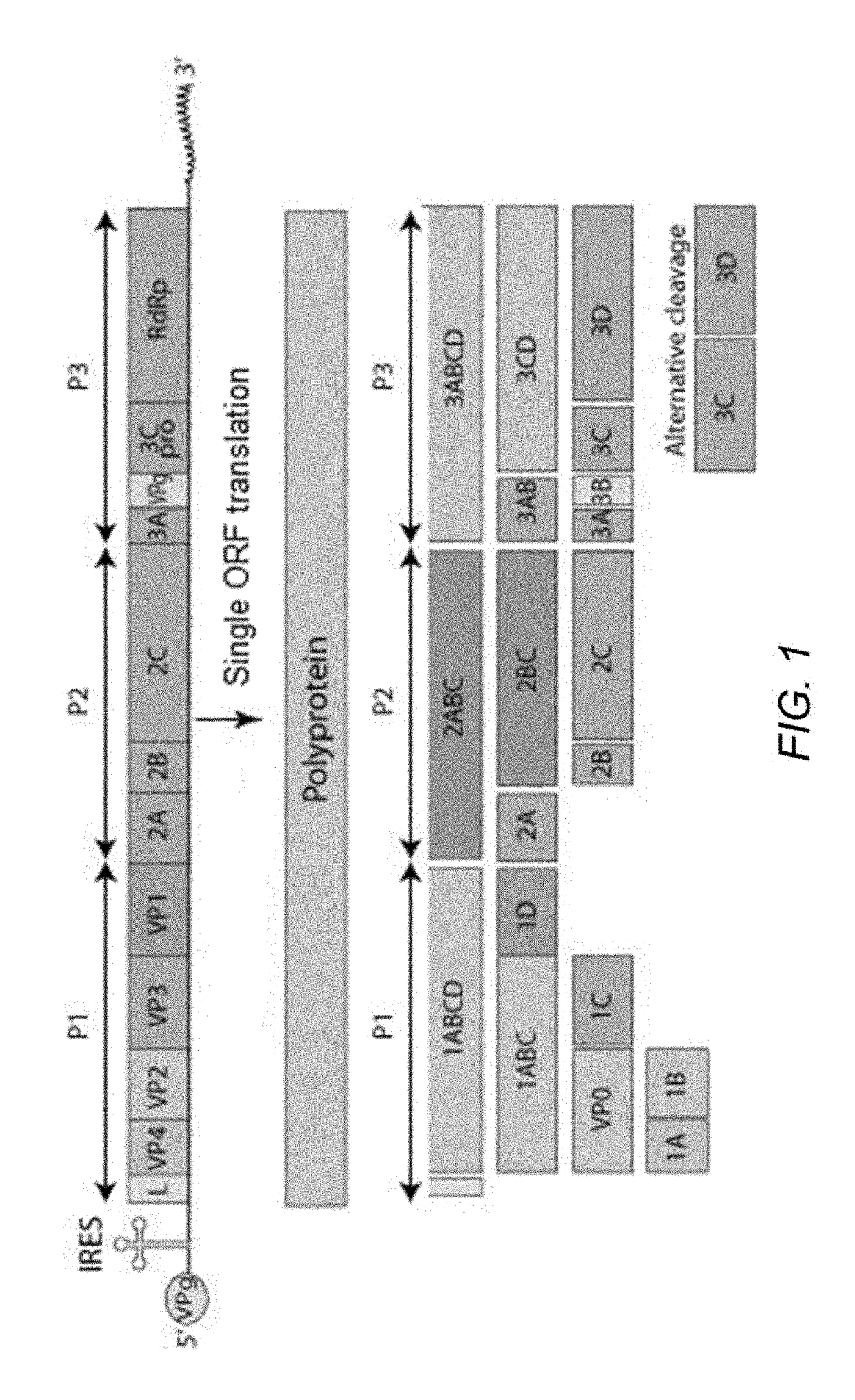Modified Foot-And-Mouth Disease Virus 3C Proteases, Compositions And Methods Thereof
a technology of 3c proteases, which is applied in the field of modified foot and mouth disease virus 3c proteases, can solve the problems of high cost, high cost, and high cost of containment of fmdv, and achieve the effects of reducing the toxic, inhibitory and other deleterious effects, and poor recombinant yield of p1
- Summary
- Abstract
- Description
- Claims
- Application Information
AI Technical Summary
Benefits of technology
Problems solved by technology
Method used
Image
Examples
examples
[0391]The examples below are intended to further illustrate various protocols, including protocols for preparing and characterizing mutant FMDV 3C proteases, transgene expression cassettes carrying the mutant FMDV 3C proteases, vectors carrying the transgene expression cassettes, host cells transformed with the vectors, virus-like particles assembled and formed inside the host cells, DNA constructs or chimeras fusing a Gaussia luciferase gene (GLuc) or a super-luminescent Gaussia luciferase (SGLuc) with a foot-and-mouth disease virus (FMDV) translational interrupter sequence and an FMDV virus-like particle or VLP-expressing construct, and a mechanism for enhancement for transgene output by mutant FMDV 3C proteases. These examples are not intended to limit the scope of the claims. While these examples are provided for explanatory purposes, these should not be considered the only examples. Additional examples will be apparent based on the teachings of the present disclosure.
examples 1-15
Overview of Examples 1-15
[0392]In the following Examples 1-15, in order to examine the effect of the expression of wild-type and mutant FMDV 3C proteases on transgene output, a luminescence assay that utilizes a chimera (Gluc-3C) of Gaussia princeps luciferase (GLuc) and an FMDV 3C protease (3C) was developed to monitor and quantify the cytotoxic effect that FMDV 3C protease expression has on transfected mammalian cells and total transgene output of transfected cells expressing the FMDV 3C protease. GLuc (SEQ ID NO: 201) is a small, naturally secreted luciferase of 185 amino acids (encoded by SEQ ID NO: 145 or 200). GLuc has a higher intensity when compared to firefly or Renilla luciferases making it ideal for studies which may involve only a small amount of peptide. A mutation of amino acids 89 and 90 in GLuc produces a super luminescent GLuc variant known as SGLuc (SEQ ID NO: 203), encoded by SEQ ID NO: 146 or 202 useful for examination of low levels of protein expression. GLuc is...
example 1
Insertion of GLuc into pTarget
[0399]Template DNA for GLuc was PCR amplified using OneTaq 2× Master Mix with Standard Buffer (New England Biolabs) and primers Ascl-Kzk-Gluc-F (SEQ ID NO: 182) and Gluc-NS-NheI-R (SEQ ID NO: 181) per manufacturer's instructions. Insertion into the pTarget vector (Promega) followed manufacturer's instructions for T / A cloning. Transformants were plated on LB Agar plates with 100 ug / ml carbenicillin (Teknova). To confirm mutation-free insertion, the plasmids were sequenced using primers T7 (SEQ ID NO: 179) and Seq-R (SEQ ID NO: 180). Sequencing data was analyzed using the Sequencher 4.8 program (Genecodes).
PUM
| Property | Measurement | Unit |
|---|---|---|
| Fraction | aaaaa | aaaaa |
| Fraction | aaaaa | aaaaa |
| Fraction | aaaaa | aaaaa |
Abstract
Description
Claims
Application Information
 Login to View More
Login to View More - R&D
- Intellectual Property
- Life Sciences
- Materials
- Tech Scout
- Unparalleled Data Quality
- Higher Quality Content
- 60% Fewer Hallucinations
Browse by: Latest US Patents, China's latest patents, Technical Efficacy Thesaurus, Application Domain, Technology Topic, Popular Technical Reports.
© 2025 PatSnap. All rights reserved.Legal|Privacy policy|Modern Slavery Act Transparency Statement|Sitemap|About US| Contact US: help@patsnap.com



